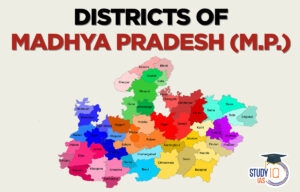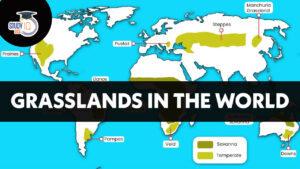Table of Contents
Deserts are vast, barren landscapes that are characterized by extreme climatic conditions, minimal precipitation, and unique ecosystems. Among the world’s many deserts, the largest holds a distinct place due to its immense size and geographical importance. In this article, we delve into the details of the largest desert in the world, including its name, location, type, and area.
What Are Deserts?
Deserts are barren land areas characterized by minimal precipitation. Specifically, a region is classified as a desert if it receives less than 10 inches (250 millimeters) of rainfall annually. This scarcity of water leads to unique ecological and climatic conditions that influence both the environment and the species that inhabit these regions.
Largest Desert in the World – Overview
| Feature | Description |
|---|---|
| Name | Antarctica Desert |
| Location | Antarctic Continent (Southern Hemisphere) |
| Type | Cold Desert |
| Area | 14 million square kilometers |
| Annual Precipitation | Less than 50 mm (mostly as snow) |
Types of deserts
Deserts are classified based on their climate, geographical location, and environmental characteristics. While the common perception of deserts often conjures up images of vast, sandy landscapes under scorching sun, deserts can exist in various forms. Here are the four main types of deserts:
Hot and Dry Deserts
Characteristics:
- Temperature: Extremely high during the day and can drop significantly at night.
- Precipitation: Very low, typically less than 250 mm annually.
- Soil: Sandy or rocky with minimal organic matter.
- Flora and Fauna: Plants like cacti and small shrubs with adaptations to conserve water. Animals like camels, lizards, and insects are common.
Examples:
- Sahara Desert (Africa): The world’s largest hot desert, known for its vast dunes and harsh conditions.
- Mojave Desert (USA): Famous for the Joshua tree and extreme temperatures.
- Thar Desert (India and Pakistan): Known for its arid climate and sand dunes.
Cold Deserts
Characteristics:
- Temperature: Extremely low, with sub-zero temperatures during winter.
- Precipitation: Low, mostly as snow or ice.
- Soil: Often frozen, with a layer of permafrost.
- Flora and Fauna: Limited vegetation; animals like penguins, seals, and cold-adapted microorganisms thrive.
Examples:
- Antarctic Desert: The largest desert in the world, characterized by ice sheets and extreme cold.
- Arctic Desert: Found around the North Pole, with icy landscapes and harsh weather.
Coastal Deserts
Characteristics:
- Location: Found along coastal regions where cold ocean currents meet land.
- Temperature: Moderate to high during the day and cooler at night.
- Precipitation: Low but often accompanied by fog.
- Flora and Fauna: Specialized vegetation like salt-tolerant plants; animal life includes seabirds and reptiles.
Examples:
- Atacama Desert (Chile): One of the driest places on Earth, receiving little to no rainfall.
- Namib Desert (Africa): Known for its towering dunes and unique wildlife like the oryx and desert-adapted elephants.
Semi-Arid Deserts
Characteristics:
- Temperature: Moderate to high, with significant seasonal variations.
- Precipitation: Slightly higher than hot deserts, averaging 250–500 mm annually.
- Soil: Fine-textured and often rich in nutrients but lacks moisture.
- Flora and Fauna: Grasses, shrubs, and small trees; animals like foxes, birds, and rodents.
Examples:
- Great Basin Desert (USA): Known for its sagebrush vegetation.
- Karakum Desert (Central Asia): Semi-arid with cold winters and hot summers.
Comparison of Desert Types
| Type | Climate | Precipitation | Examples |
|---|---|---|---|
| Hot & Dry Deserts | Very hot days, cool nights | <250 mm | Sahara, Mojave, Thar |
| Cold Deserts | Sub-zero temperatures | <250 mm | Antarctic, Arctic |
| Coastal Deserts | Moderate temperatures | Very low | Atacama, Namib |
| Semi-Arid Deserts | Moderate temperatures | 250–500 mm | Great Basin, Karakum |
Largest Desert in the World
Antarctica is the largest desert in the world in terms of size covering 14.2 million square kilometres (5.5 million square miles). The coldest desert on the Earth has temperatures as low as -89°C (-128.2°F). It is mainly covered by ice flats and ice sheets, with an ice thickness of an average of 2.45 kilometres (1.5 miles). It is considered a desert because it receives less than 50 mm (1.9 in) of precipitation annually on average. Animals that live there are primarily carnivores, such as penguins, albatrosses, whales, and seals, but there’s almost no vegetation.
Also, Check Largest Volcanoes in World
List of Largest Deserts in the World
Deserts cover roughly one-third of the Earth’s land surface. Deserts are classified into four types based on their geographic location: polar deserts, subtropical deserts, cold winter deserts, and cool coastal deserts. The table below lists the 25 Largest Deserts in the World along with their dimensions, types, and locations.
| List of Largest Deserts in the World | ||||
| Important Deserts | Type of Desert | Location | Area (sq mi) | Area (km²) |
| Antarctica | Polar ice and tundra | Antarctica | 5500000 | 14000000 |
| Arctic | Polar ice and tundra | Northern Europe (Finland, Iceland, Norway and Sweden) Northern America (Alaska, Canada and Greenland) Eastern Europe (European Russia) North Asia (Siberia) | 5400000 | 13985000 |
| Sahara | Subtropical | West Africa (Mali, Mauritania and Niger) North Africa (Algeria, Egypt, Libya, Morocco, Sudan and Tunisia) Middle Africa (Chad) East Africa (Eritrea) | 3,300,000 | 9,000,000 |
| Australian Desert | Subtropical | Australia | 1000000 | 2700000 |
| Arabian Desert | Subtropical | Western Asia (Iraq, Jordan, Kuwait, Oman, Qatar, Saudi Arabia, United Arab Emirates and Yemen) | 900000 | 2,330,000 |
| Gobi Desert | Cold Winter | East Asia (China and Mongolia) | 500000 | 1295000 |
| Kalahari Desert | Subtropical | Middle Africa (Angola) Southern Africa (Botswana, Namibia and South Africa) | 360000 | 900,000 |
| Patagonian Desert | Cold Winter | South America (Argentina and Chile) | 200000 | 620000 |
| Syrian Desert | Subtropical | Western Asia (Iraq, Jordan, and Syria) | 200000 | 520,000 |
| Great Basin | Cold Winter | United States | 190000 | 492,000 |
| Chihuahuan Desert | Subtropical | Central America (Mexico) Northern America (United States) | 175000 | 450,000 |
| Karakum Desert | Cold Winter | Turkmenistan | 135000 | 350,000 |
| Colorado Plateau | Cold Winter | United States | 130000 | 337,000 |
| Sonoran Desert | Subtropical | Central America (Mexico) Northern America (United States) | 120000 | 310,000 |
| Kyzylkum Desert | Cold Winter | Central Asia (Kazakhstan, Turkmenistan and Uzbekistan) | 115000 | 300,000 |
| Taklamakan Desert | Cold Winter | China | 105000 | 270000 |
| Thar Desert | Subtropical | Indian Subcontinent (India and Pakistan) | 77000 | 200,000 |
| Dasht-e Margo | Subtropical | Afghanistan | 58000 | 150000 |
| Registan Desert | Subtropical | Afghanistan | 56400 | 146000 |
| Atacama Desert | Mild Coastal | South America (Chile and Peru) | 54000 | 140,000 |
| Mojave Desert | Subtropical | United States | 48000 | 124,000 |
| Columbia Basin | Cold Winter | United States | 32100 | 83,100 |
| Namib Desert | Cool Coastal | Southern Africa (Namibia) Middle Africa (Angola) | 31000 | 81,000 |
| Dasht-e Kavir | Subtropical | Iran | 30000 | 77,000 |
| Dasht-e Loot | Subtropical | Iran | 20100 | 52,000 |
1. Antarctic Desert
- Name: Antarctic Desert
- Location: Antarctica (Continent)
- Type: Polar Ice Desert
- Area: 14,200,000 sq km
Key Points:
- The Antarctic Desert is the largest desert in the world by area.
- It is characterized by its icy, arid conditions and extremely low temperatures.
- The region is covered with ice and snow year-round, making it a polar ice desert.
- Vegetation is minimal, with only mosses and lichens surviving in this harsh environment.
- It plays a crucial role in Earth’s climate regulation and has a unique ecosystem adapted to extreme cold.
2. Arctic Desert
- Name: Arctic Desert
- Location: Eastern Europe, North America, North Europe
- Type: Polar Ice Desert
- Area: 13,900,000 sq km
Key Points:
- The Arctic Desert is the second-largest desert globally.
- It encompasses the Arctic region, including parts of Canada, Finland, Greenland, Iceland, Norway, and Russia.
- Similar to the Antarctic Desert, it features icy conditions and minimal vegetation.
- It is important for understanding global climate patterns and the effects of climate change in polar regions.
3. Sahara Desert
- Name: Sahara Desert
- Location: Northern Africa
- Type: Subtropical Desert
- Area: 9,200,000 sq km
Key Points:
- The Sahara Desert is the largest hot desert and the third-largest overall.
- It spans across several countries: Algeria, Chad, Egypt, Mali, Morocco, Niger, and Western Sahara.
- Characterized by extreme temperature variations, from scorching heat during the day to freezing temperatures at night.
- The desert features vast sand dunes, rocky plateaus, and sparse vegetation adapted to arid conditions.
4. Great Australian Desert
- Name: Great Australian Desert
- Location: Australia
- Type: Subtropical Desert
- Area: 2,700,000 sq km
Key Points:
- The Great Australian Desert is the fourth-largest desert globally.
- It covers much of the interior of Australia and includes several smaller deserts within it.
- It experiences extreme temperature fluctuations and has unique flora and fauna adapted to its arid environment.
5. Arabian Desert
- Name: Arabian Desert
- Location: Western Asia
- Type: Subtropical Desert
- Area: 2,330,000 sq km
Key Points:
- The Arabian Desert is the largest desert in Asia.
- It stretches across countries such as Iraq, Jordan, Kuwait, Oman, Qatar, Saudi Arabia, and Yemen.
- Known for its vast sand dunes and sparse vegetation, it experiences extreme heat and aridity.
6. Gobi Desert
- Name: Gobi Desert
- Location: Eastern Asia
- Type: Cold Winter Desert
- Area: 1,295,000 sq km
Key Points:
- The Gobi Desert is notable for its cold, dry conditions and significant temperature variations.
- It spans parts of China and Mongolia.
- Unlike hot deserts, it experiences harsh winters and is characterized by rocky terrain and sparse vegetation.
Also, Check Deserts of India
Major Largest Desert in the World
The world has many deserts, ranging from small and isolated to vast and sprawling. The major Deserts of the World are the Antarctica Desert, Arctic Desert, Sahara and so on. Here are some of the world’s major deserts:
Antarctica
Antarctica is the largest desert in the world, which is around 14 million square kilometres (5,500,000 square miles) in size. It is a desert, which is defined as a region with little or no precipitation, despite being coated in ice and snow. The Antarctic Desert is found on the continent of Antarctica in the southern hemisphere.
Arctic Desert
With over 13.7 million square kilometres, the Arctic Desert is the second-largest desert in the world. It is mostly in Canada, Greenland, and Russia, which make up the northernmost region on the planet.
Sahara Desert
The Sahara Desert is the Largest Hot desert in the world. With a surface area of approximately 9 million square kilometres, the Sahara is the third-biggest desert overall and the largest hot desert in the world. From the Atlantic to the Red Sea, it is situated in northern Africa.
Arabian Desert
With over 2.3 million square kilometres, the Arabian Desert is the fourth-largest desert in the world. It is mostly in Saudi Arabia on the Arabian Peninsula.
Gobi Desert
With a surface area of over 1.3 million square kilometres, the Gobi Desert is the fifth-largest desert in the world. It can be found in southern Mongolia, as well as northern and western China.
Also, Check Mountain of India
Largest Desert in India
The Thar Desert is the Largest Desert in India, also known as the Great Indian Desert. It accounts for approximately 4.56% of India’s total land area. It is located on the border between Pakistan and India and covers an area of approximately 200,000 km2 and, with the remaining 15% in Pakistan. The Desert is a Large and dry region in the northwest of the Indian Subcontinent. The Great Indian Desert is comprised of the Rann of Kutch on the western coast, the alluvial plains of the Indus River in the northwest, Punjab and Haryana to the north, and the Aravali Hills in the northeast.


 Districts of MP List, Name, Importance, ...
Districts of MP List, Name, Importance, ...
 Critical Minerals, Key Issues, Importanc...
Critical Minerals, Key Issues, Importanc...
 Grasslands in the World, Map, Types and ...
Grasslands in the World, Map, Types and ...





















